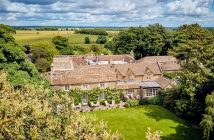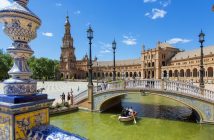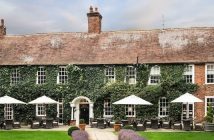When finally we spotted the bright eyed, dark haired Rajesh bouncing towards us like an effervescent squirrel, my partner and I collectively sighed with relief. We had been travelling on India’s train network for nearly 20 hours, finally landing at New Jalpaiguri at lunchtime, the last major train station before the ascent into the West Bengal mountains. But, in our travel haze and hastiness to escape the confines of carriage A1, we’d failed to remember that we were due to meet our pick up on the platform rather than at the station entrance. Twenty minutes of trawling back and forth passed before, finally, we saw the huffing and puffing Rajesh careening towards us.
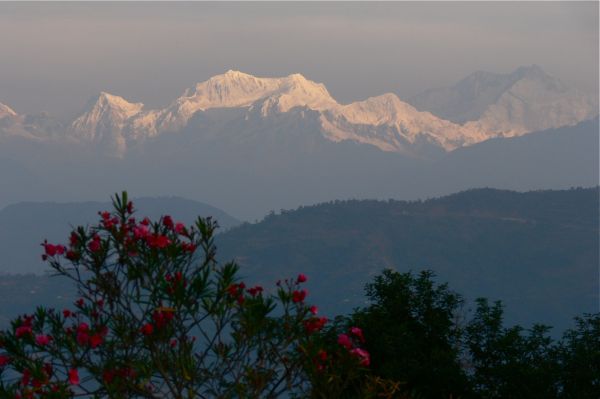
“For Glenburn?” he asked, obviously panicked, fearing he had lost his passengers in the sea of arrivals. With smiles and laughs all around, we attempted to explain the mix-up but he looked almost crestfallen to have not begun providing us five-star service as soon as our weary selves pulled into the station. As one of the employees of the Glenburn Tea Estate – a colonial era working tea farm and now, boutique hotel near Darjeeling in India’s north east – the best service was engrained in his being. Leading us to the car – amidst questions of, “Are you okay now ma’am?” and “Sir, is everything fine?” – we settled back down for another three hours of travel.
Glenburn Tea Estate was started by Scotsman Kimble Murray in 1859 but has been owned by the Prakesh family for four generations. It produces outstanding Darjeeling tea on its 1,900 acre estate and, inspired by French wineries which have châteaus for visitors to reside in, decided a decade ago to diversify into the hotel trade by transforming one of the major on-site buildings called the Burra Bungalow into top-end hotel suites. It has since built a second building – the Water Lily Bungalow – to keep up with demand.
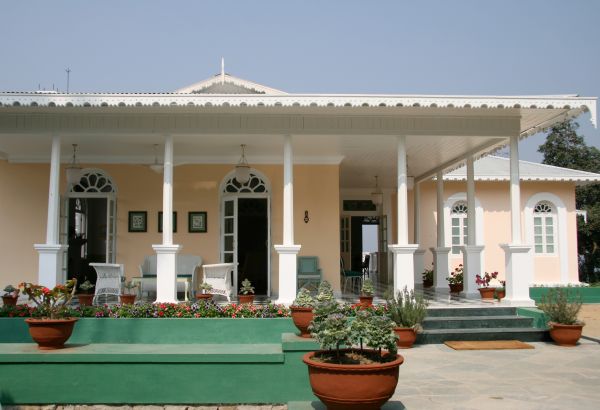
But getting there is no easy journey. Like every Indian road trip the route to the Estate is comically petrifying. Climbing up thousands of feet along perilous, landslide prone roads, our 4×4 honked its way on the wrong side of the road past slower cars and lumbering trucks. Giant beasts – buses, transport trucks – emerged frequently from the dust, appearing like ghosts to nearly sideswipe our vehicle, while chattering, bouncing monkeys stood on the narrow, winding road’s edge pointing and laughing at our human folly of negotiating the track in our metal boxes. Thousands of feet below, the Teesta River flowed silver-blue like a sorceress’s outstretched cape, while beside us houses painted with a 1980s colour scheme – cobalt blue, canary yellow, hot pink – flashed past the windows.
When finally we bumped and jangled our way down a single lane dirt track, reversing frequently to let cars and cows pass, Glenburn emerged like a mirage to our travel-stained eyes. The Burra Bungalow was everything I had imagined a colonial escape to be: white wicker chairs dotted themselves along a stretched marble veranda, fronted by white pillars covered in drooping, climbing plants and backed by an apricot-coloured wall.
On hand to greet us was hostess Neilu, who plied us with lemon iced tea and questions about our journey. Noting our dusty clothes and frizzy, unkempt hair, she soon led us to the Planter’s Suite – our home for the night.
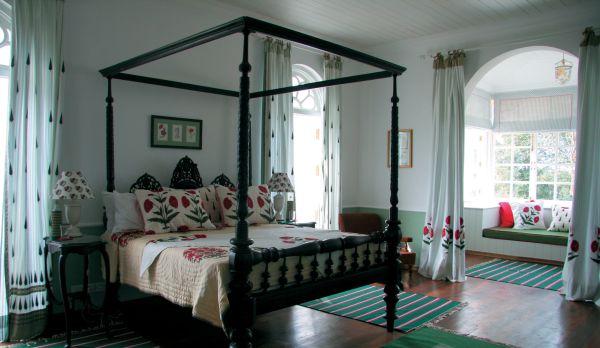
Inside our room, it was a dream. Dark wood floors, a white marble fireplace, ancient framed maps and the largest bed in history greeted us; our dusty backpacks felt almost an insult to its beauty. In the bathroom, a roll-top pearl toned bathtub rested beside a rectangular window, through which flitted the last of the day’s sunshine, while next door a separate seating area with bay windows fronting onto the garden and featuring a spongy, plush window seat and dark framed rockers exuded comfort amidst the luxury. It was so tasteful I could have eaten it. Instead, I shed my clothes, soaked in the bath and took advantage of the hotel’s complimentary express clothes washing and ironing service.
Suitably suited and booted, the boy and I emerged from the Planter’s Suite after dark, only to be further awed. All around the estate, tucked into the surrounding mountainsides, lights had plucked on like thousands of fireflies dancing across the landscape; houses which we’d not detected in the daylight suddenly became visible, creating a magical, starry expanse.
In the fairy-light lit garden, the rest of the hotel’s guests were gathering for the traditional pre-dinner drinks. Unlike other hotels, Glenburn is truly boutique, allowing only enough guests as can fit around the chunky, wooden table in the dining room. Each evening, drinks are served outside by gloved, white-clothed footmen before guests gather in the main dining room for dinner. It’s all a bit A Room with a View as one guest – a perky, friendly Brit-turned-Dubai resident – put it. After a few gin and tonics, we wandered into the romantically lit dining room, chatting comfortably with the other eight guests who were keen to share tales of their time at Glenburn.
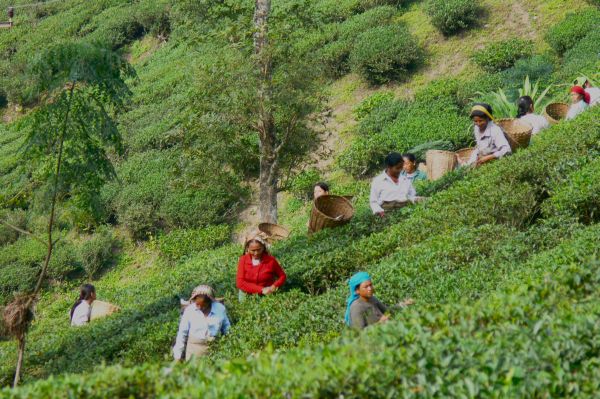
The meal passed in a haze – course upon course of Indian cuisine made their way around the table, with footmen dolloping portions onto each plate akin to an evening scene from Downton Abbey. I conversed with the perky Brit’s husband while the boy entertained those on the other side of the table. I finished each bit of food and glass of wine with a relaxed enjoyment that only comes from being in the company of truly interesting people.
With a heavy head, the boy and I finally retired to our room – having stayed up far later than the other guests to drink more wine with manager Sanjay Sharma and the owner’s son, Anshuman – and awkwardly climbed (quite literally; they provide a stool for shorter guests who can’t reach the mattress) into our bed. But not for long – a few hours later, I roused myself to pad out into the crisp air and watch the sun rise over the Kangchenjunga mountain – the world’s third highest, which is a part of the Himalayan range. Glenburn is in the enviable position of having a clear view of its snowy, sharp edged peaks. In the morning silence, it was angelic.
Later, after a comforting breakfast under a drooping pomelo tree, we headed out with Sanjay on a tour of the tea estate. In the fresh daylight, it was incredible to see the sweeping landscape all owned by Glenburn. Acre upon acre of bushy shrubbed tea plants stretch further than the eye can squint, while in the distance brightly clothed, Nepalese-looking women carried wicker baskets on their backs already brimming with lime green tea leaves.
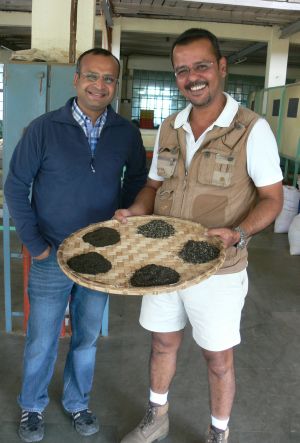
On the grounds, Sanjay showed us the nurseries where many a new tea plant variety were being trialled, along with his latest experiment of an oversized compost bin where the scraps from the hotel’s kitchens were being transformed into cool, dark dirt by hard working earthworms.
The tea in the region is produced from March to early December, going through four ‘seasons’ during that time: the first flush, second flush, monsoon flush and autumn flush. Everything is produced on site in a hands-on process, from the withering of the freshly picked leaves to reduce moisture, to rolling in small batches in special machines, to give each leaf style.
“Tea is about the senses,” explains Sanjay. “Not only should it taste good, but it should look good too.” The tea is then fermented to help develop its flavour. “If you under ferment, you end up with an overly astringent product; if you over ferment, you end up with a bland cup. And at the end of the day, we have to have the perfect cup of tea in mind.”
It is then dried – each type of tea is handled differently, with varying degrees of heat and lengths of time applied in a scientific manner. Finally, they’re hand sieved to separate it into different grades of tea, which determines its final price. And the products do vary considerably. Sanjay took us through a tea tasting, in which we discovered the striking differences between teas dependent on the time of year produced. Some smelled of apricot and rose petals, while others had dark chocolate, damp earth or vegetable notes. Not unlike a wine tasting, each was reverently presented at its correct temperature to best explore the individual flavours.
Glenburn is not only about the tea, however, as Sanjay also explained. The Estate also comprises eight villages, in which its 956 permanent staff and 300 temporary workers live, along with their families. There are three primary schools and a 16-bed hospital provided for them too.
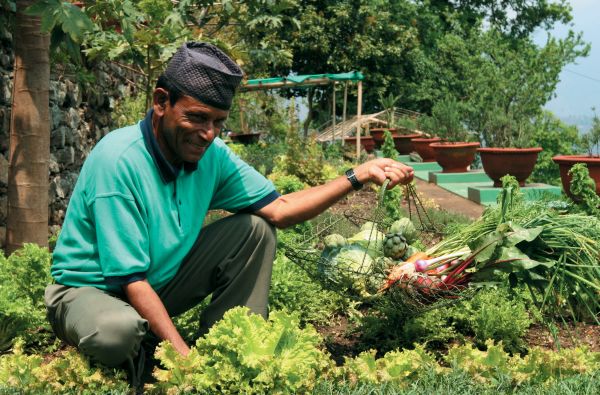
After our tour, the boy and I hopped into a 4×4 for a 45 minute, bone-jarring ride down to the riverside – the outer border of the Estate, also known as ‘the camp’, a more rustic lodge set alongside the bubbling, frothing river. We had been told we were going for a picnic but upon arrival it was the most elaborate picnic I’d ever come across: five waiters stood to attention by a perfectly laid table; cold beer was poured as we sat down, and a dozen dishes were served from the kitchen. With the picturesque setting, it was nearly perfect – only the flitting bugs bothered but we attempted to be at one with nature and ignore them.
When finally we departed Glenburn as the sun was nearing its last moments in the sky, we did so with heavy hearts. It was no ordinary luxury escape, we had learned about the local community and the tea making process, met a fantastic bunch of strangers, relaxed in perfectly harmonious luxury and did all that in an incredibly beautiful setting. Rumours abound that famed director Wes Anderson stayed and was inspired to title his film The Darjeeling Limited based on a sign found on-site. While that film is mainly set in Rajasthan, there is no doubt that Glenburn would inspire most. I felt as if I’d lived a dream by simply visiting its wonderful setting.
Glenburn Tea Estate, Darjeeling, India. The nightly rate starts at 23,000r (£257) based on two adults sharing, and includes transfers to and from the Estate to New Jalpaiguri station or Bagdogra airport, all meals, laundry services, personalised Estate tours, nature walks, optional overnight stay at the Camp and day trips to Darjeeling and Sikkim. For more information, visit the website.
[wzslider]

